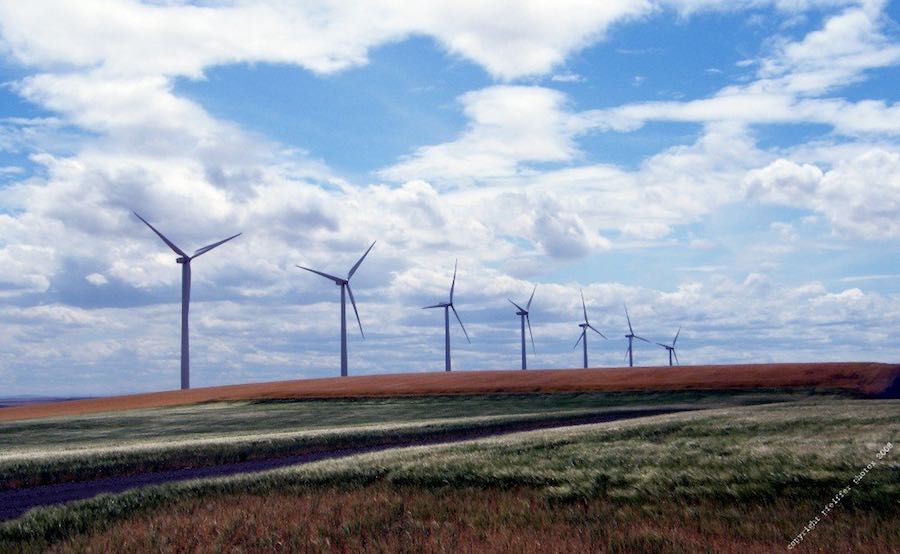
In its first release of the monthly Energy Infrastructure Update for 2016, the Federal Regulatory Commission (FERC) reports five new “units” of wind and six new units of solar accounting for 100 percent of new electrical generation brought into service for January, with 468 megawatts (MW) and 145 MW respectively.
Renewable energy sources from wind, solar, biomass, geothermal and hydro now deliver 17.93 percent of all installed generating capacity in the United States. Breaking it down by energy source, generating capacity from renewables as an aggregate of the total looks like this:
- Hydropower: 8.56 percent
- Wind: 6.37 percent
- Biomass: 1.43 percent
- Solar: 1.24 percent
- Geothermal: 0.33 percent
Even taking hydropower out of the equation, renewable energy sources from wind, solar, biomass and geothermal exceed installed capacity for both nuclear (9.15%) and oil (3.84%).
The numbers for January reflect the ongoing trend firmly established over the past several years. FERCs December 2015 Energy Infrastructure Update reported that renewables contributed 64 percent, nearly two-thirds, of all new electrical generating capacity installed last year.
A separate report from the U.S. Energy Information Administration (EIA), the latest Electric Power Monthly reports on all 12 months of 2015, showing electricity generated by renewable sources grew 2 percent as compared to 2014, supplying 13.5 percent of all utility-scale U.S. electrical output in 2015.
Underestimating the trend – still
One important aspect of renewable energy development also highlighted the Electric Power Monthly report is the EIAs own enduring inability to accurately forecast the growth of renewable energy in the United States.
Just three months ago, in its Short-Term Energy Outlook, EIA said it expected “total renewables used in the electric power sector to decrease by 1.8% in 2015. Hydropower generation is forecast to decrease by 8.2%, and non-hydropower renewable power generation is forecast to increase by 4.2 percent.”
In fact, compared to calendar year 2014, non-hydro renewables increased by 6.9 percent, hydro output declined by just 3.2 percent, and the total of hydropower plus non-hydro renewables grew by 2.03 percent.
Grid-scale renewables accounted for 13.44 percent of net U.S. electrical generation in 2015, up from 13.16 percent in 2014. Non-hydro renewable sources provided 7.30 percent of the total, conventional hydro 6.14 percent and generation from all non-hydro sources grew in 2015.
Non-hydro renewable energy growth in 2015
- Biomass up 0.3 percent
- wind up 5.1 percent
- geothermal up 5.6 percent
- solar up 49.6 percent
This growth trend in renewable energy is reflected by the trend of government forecasters to continually underestimate the pace of this growth. In the Annual Energy Outlook 2012 report, the EIA predicted that non-hydro renewables would grow at an annual rate of 3.9 percent and provide about 250,000 thousand megawatt-hours in 2015 while non-hydro renewable electrical generating capacity would reach approximately 85 gigawatts (GW). It also forecast that non-hydro renewables would not surpass hydropower until 2020.
EIA now reports actual generation from non-hydro renewables in 2015 reached 298,358 thousand megawatt-hours from utility-scale facilities alone; in addition, at least 12,141 thousand megawatt-hours was provided by distributed solar photovoltaic and an unknown amount from other distributed, small-scale renewables that are not grid-connected (e.g., small wind). Further, electrical generation from non-hydro renewables surpassed that from hydropower more than a year ago.
According to FERC, the total installed generating capacity of wind, biomass, solar, and geothermal units had reached 109.6 GW by January 2016 – and this reflects just the combined capacity of larger renewable energy facilities. FERC’s data only includes plants with nameplate capacity of 1 MW or greater and therefore does not reflect the additional capacity provided by rooftop solar or other smaller, distributed renewable energy systems.
“Just a few years ago EIA had forecast that renewables might provide 15 percent of the nation’s electricity by 2035,” noted Ken Bossong, Executive Director of the SUN DAY Campaign. “It now appears that goal could be reached within the next two years and quite possibly sooner!”
Despite the consistent low-balling from government projections, renewable energy is charting its own path, very possibly reaching EIA estimates for 2035 fifteen or more years early. As reflected in the Paris Agreement signed adopted in December and the Sustainable Development Goals in September, the shift to a new energy economy is not only imperative, it is inevitable, and happening apace. It can only be helped when government forecasting more accurately anticipates and predicts this new reality.
—–
** Note that generating capacity is not the same as actual generation. Electrical production per MW of available capacity (i.e., capacity factor) for renewables is often lower than that for fossil fuels and nuclear power. As noted, the total installed operating generating capacity provided by renewables in 2015 was about 18% of the nation’s total whereas actual electrical generation from renewables last year was roughly 13.5%; however, both of these figures understate renewables’ actual contribution because neither EIA nor FERC fully accounts for all electricity generated by distributed renewable energy sources (e.g., uncounted U.S. rooftop solar is equal to about 45% of utility-scale solar capacity and generation).
Image credit: Chris and Tina Pfeiffer, courtesy flickr


